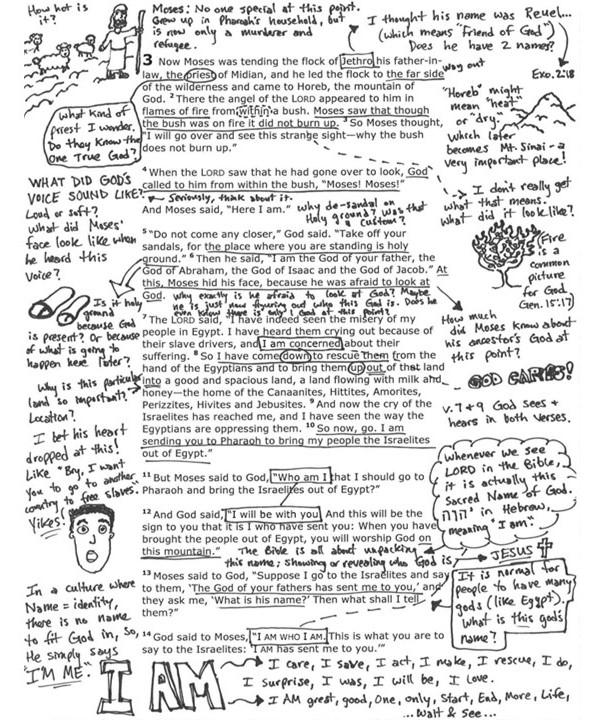Bryant Russ is coaching students to “not finish” the Bible. Huh?
“The Bible is designed for lifelong engagement. It is not a book you’re meant to ‘finish,’” said Bryant, a lead teacher for the 2020 CSI Bible Instruction Symposium and a Bible teacher at Holland Christian Schools in Michigan. “Most forms of modern literature are produced to communicate information, but the Bible is for meditation and transformation, not just information.”
It can feel odd to a task-oriented teacher, but Bryant has been fighting the urge to “cover things” and is seeking to help students “notice things.” He has introduced skill-based Bible teaching to the staff at Holland Christian School, and together they have been rethinking their practices in the Bible classroom. Many teachers are now aiming for slower, attentive, and reverential reading of Scripture as students practice skills of marking up the text.
“In the past, Bible instruction was tied to the person teaching it, and sometimes teachers stayed for forty years. But with modern turnover and a group of younger teachers, there’s been a lot of conversation about how to teach Bible. We’ve been doing, as a department, what we do at the Bible Instruction Symposium—sharing best practices. I sense that shift in other schools, too.”
Bryant shared with us a five-part model he has honed to coach students in repeated readings of Scripture: Chew, Dig, Dress, Listen, and Move.
1. Chew
When a dog has a savory bone, does he gulp it down? No. There is so much flavor, so much to savor, that he chews and chews on his bone. Sometimes we have been guilty of treating the Bible as fast food. We want a quick nugget of encouragement, a quick word of advice, rather than letting God’s truth marinate in us.
We can counteract this tendency toward immediacy by teaching students to read the text slowly, read it more than once, and track what insights they found on the first reading versus a later reading. When students see that profound insights often come later in the process, they will start to understand the benefit of “chewing” (or meditating) on the Bible.
Ask students to read the text in two translations. This simple tip opens up discoveries, especially when a word-for-word translation is paired with a thought-for-thought translation. Students will record different observations from hearing the passage phrased differently, reinforcing that we can always go deeper in the text.
2. Dig
Next, have students ask questions to dig into the text. Mark it up with ink! Look for context, name meanings, unfamiliar words, and patterns. This process may eventually result in going to a commentary, but the first step is to ponder and verbalize our wonderings. Ask, “What questions do you have?” and ask it repeatedly. Don’t settle for merely a question or two from students.
Bryant’s impetus for igniting student inquiry and discovery was an Intro to Bible class for Chinese exchange students. Their level of inquiry was so refreshing. “I became frustrated with the sense that, in my traditional Bible class, I was giving answers to questions students weren’t even asking,” Bryant said. “In contrast, I had international students who were growing and curious, so I wondered, how do we get students to do the pedaling? To engage? To move this bike?”
Writing student questions on the board or on paper to create a “wall” of questions can help them visualize how BIG their engagement should be. Ask them to mark up their Bibles with both observations and questions, underlining and writing in the margins. Finally, provide students with resources for research, coaching them in how to best use a study Bible, a commentary, or internet tools.
“What I love about this approach is that I’m not the one filling their buckets with information; I’m lighting a fire in them,” Bryant reflected. “Their marked-up Bibles become a picture of their engagement.”
3. Dress
Third, coach students to “dress” in the text by using their imagination. Get into the shoes of the Bible characters: What would it have been like? Try to imagine from multiple characters’ perspectives. Consider having students rewrite the story as a dialogue or journal entry from one character’s point of view. Bryant’s students have written about the Easter events from the perspective of the donkey and the tomb.
“The Bible may actually be designed to make you think about how to interpret it,” Bryant noted. “Modern novels give huge descriptions, but the biblical text doesn’t do that. For instance, we’re rarely told the motives of individuals, so part of you has to be involved in thinking about their motives. The Bible promotes contemplation.”
One day one of Bryant’s students asked about the throne room of God in Isaiah 6: What would the seraphim voices sound like? Would it be like falling water? A shaking thunder? It spurred great conversation and reflection about the awe of God’s throne room. Bryant reflected, “With this kind of question, we’re not going to get the ‘right’ answer. It’s about imaginatively entering in, experiencing the text in a new and more profound way.”
4. Listen
John 5:39–40 warns students to not merely “study the Scriptures diligently” but to come to Christ for life. Mere knowledge of the Bible is never our final goal. The goal is to connect with God through Jesus Christ and align our hearts with the heart of God—loving what he loves and grieving what he grieves. We want to engage with the Bible humbly and prayerfully, asking the Spirit to speak to our hearts, and bringing God’s Word back to him in conversation.
One way we teach students to “listen” is by modeling this ourselves—sharing our own thoughts and convictions from the text. We can model the traits we desire like attentiveness, reverence, and a humble willingness to change and grow. Our classroom prayers should include our request for the Holy Spirit to work on our hearts through our passage today.
Bryant is also intentional in providing opportunities for prayer. He carves out time for students to keep a prayer journal before they read, while they read, and after they read. “I don’t read these prayer entries, and I can’t assess students’ prayer lives. That is what’s different about Bible class—something can be so, so important and yet not be graded,” he shared. “But carving out the time for prayer shows that it is important and allows each student to engage at their own level. We have to trust the Holy Spirit to work!”
5. Move
Finally, move. Act in response to something you’ve read. “There are many times in the gospels when Jesus is frustrated that people aren’t acting on their knowledge,” Bryant noted. “It’s like sitting and eating chips while watching an exercise DVD.”
Since our goal is not mere information but transformation, consider how you might provide time and opportunities for students to move from “heart” to “hands.” A couple times a semester, Bryant asks students to choose something Jesus taught and describe what that might look like in their modern context. And then, actually do it.
For example, perhaps Jesus cared for someone vulnerable. Is there someone vulnerable that you could care for? Bryant’s students considered Jesus’ message about “Forgiving your enemies and praying for those who mistreat you,” (Matthew 5:44) and they chose to reach out via text or email to apologize/forgive a person in their life. Students included a journaling component to record what the experience was like and how the person responded. Such projects don’t need to be hard or require teacher-planning, but ending with an active step will help drive the message home.
Try It Yourself!
When coaching students in the skills of attentive reading, our goal is to practice. “If reading well is a skill, then we need repeated exercises in Bible reading to gain proficiency,” Bryant explained. He has seen students engage in these five steps enough that they have become second nature. Students know to “Chew, Dig, Dress, Listen, and Move” when they approach a new passage of the Bible.
“Though we aren’t able to cover all of Scripture in four high school semesters, we are trying to teach students to fish for themselves, so they will continue to be fed by Scripture after graduation,” Bryant shared. “If we can ignite a fire, that flame can keep on burning their whole lives!”
Written by Heidi Dean

The curiosity of international students inspired Bryant to cultivate more wonder and engagement in his traditional Bible classes.

Marking up the text shows both the student and teacher how the student has engaged with the text. It makes their thinking visible!
An icon for each step serves as a memory tool. The practice becomes “perfect” when students can apply the five steps by themselves to a new text of Scripture.

